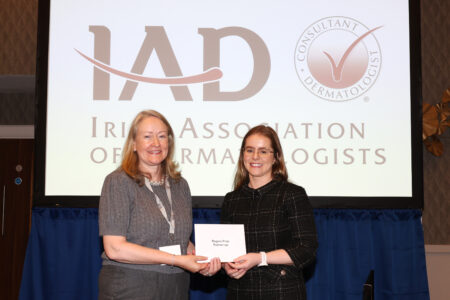2 November 2024
By Elaine Murphy
elaine@TheCork.ie
The dermatology department in the South Infirmary Victoria University Hospital (SIVUH) Cork came away with the top prizes at the recent autumn meeting of the all-island Irish Association of Dermatologists. Dr Brian Nolan and Dr Fiona Sexton were awarded first and second places in the prestigious Rogers Plate.
Dr Brian Nolan, dermatology registrar, won the Rogers Plate for best oral presentation for a mobile application ‘FootDerm’. This medical educational resource was designed for podiatrists in collaboration with consultant dermatologists Professor Michelle Murphy and Dr Cathal O’Connor. Dr Nolan designed the application in response to research conducted by the department looking into the role that allied-healthcare professionals, such as podiatrists, can play in the early detection of skin cancers. The survey, conducted in association with the Irish Chiropody/Podiatry Organisation, examined the confidence and knowledge of 247 Irish Chiropodists/Podiatrists in assessing melanoma of the lower limb. In this survey, 82% of Irish podiatrists felt that they received inadequate training in melanoma during their training.
Marie Dalton, general secretary of the Irish Podiatry/Chiropody Association commented “this research has proven to be a really worthwhile and educational endeavour for our members. All professions can play an integral role in the earlier detection of skin cancer.”
Through launching an educational mobile application, the dermatology department in SIVUH in Cork hopes that engagement with allied-healthcare professionals will continue to raise awareness and promote earlier detection of skin cancer in Ireland.
Dr. Fiona Sexton, dermatology registrar, came runner-up for research undertaken with consultant dermatologist Dr. John Bourke and consultant paediatric endocrinologist Prof. Colin Hawkes, to identify the causative allergens in diabetes technology-associated allergic contact dermatitis. This study was a multi-centre international collaboration involving researchers from SIVUH, Cork University Hospital, Trinity College Dublin and Lund University, Malmo, Sweden. The research found that many wearable devices used in the management of diabetes contain known allergens. The research undertaken will hopefully help patients with allergic contact dermatitis to select devices that are best suited to their skin.
Dr. John Bourke commented “allergy to diabetic devices is common and difficult to diagnose. Manufacturers are unhelpful in determining the constituents of the devices. Complicated patch testing and laboratory analysis were required to diagnose the cause of the problem in our patients.”
Both papers have been submitted for publication in leading dermatology journals.

